- Home
- McBain, Ed
Killer's Payoff
Killer's Payoff Read online
Killer's Payoff
Mcbain, Ed
Killer’s Payoff
Ed McBain
Introduction
Are we there yet?
Apparently not.
Ever the slave to the whims of cruel and unusual publishers, I am reluctantly continuing this seemingly incessant string of introductions, each of which is threatening to become as long as the 87th Precinct series itself. How is a mere writer supposed to remember the details of how a novel took shape in the year 1957, when Killer’s Payoff was being written?
I had my instructions.
That much I remember clearly.
Phase out Steve Carella. Carella is not a hero, he is a married man. Instead, give us a handsome hero with whom men can identify and with whom women can fall in love.
This is what I’d been told by the Pocket Books executive whom I prefer calling Ralph lest he turn his goons on me yet another time. Following the gentle persuasion that took place in the offices at 630 Fifth Avenue, I introduced the handsome new hero, Cotton Hawes, in a book titled Killer’s Choice. His debut caused no noticeable critical or popular acclaim. This did not lessen Ralph’s conviction that the series needed the shot-in-the-arm only a character of Hawes’s size and dimension could provide. In fact, and toward that end, Ralph had already concocted a slew of titles with the name “Cotton” in them, hoping to ensnare unsuspecting readers through the use of so-called Instant Newsstand Recognition.
You must remember that none of these books had as yet been published in hardcover. They were all paperback originals, and they sold for a mere twenty-five cents each—about a third of what a hit off a crack pipe will cost you at the time of this writing. In fact, if crack had been around back then, I’m sure Ralph would have suggested Cotton and Crack as one of the new titles in the new approach. As it was, he’d come up instead with such scintillating gems as Cotton and Steel, Cotton and Silk, Cotton and Smoke, and Cotton and God Knows What Else.
Back then, titles were routinely changed by publishers as a matter of course, with little regard for the author’s feelings or the intent of the book. I fought for Killer’s Payoff (which in itself wasn’t such a terrific title) because I’d already written Killer’s Choice, introducing Hawes, and I felt the next novel should echo it somewhat. Besides, I tend to think in terms of three—perhaps because Conan Doyle wrote The Sign of the Four, or perhaps, gee, just maybe because the first Pocket Books contract was for three books, and the second was for another three. Killer’s Payoff was to be the last book in that second contract. After that, Pocket could renew again or not, as they saw fit. I had the feeling that if Hawes didn’t work out as the driving force behind the series, it was goodbye, Charlie.
Upon reflection, it’s interesting to note that the first four books in the series were titled after the sort of criminals a policeman might actually encounter: Cop Hater, The Mugger, The Pusher, and The Con Man. But with the introduction of Cotton Hawes, the titles became sort of…well, private-eye sounding, don’t you think? Killer’s Choice? And then Killer’s Payoff? And I already had the third Killer’s title in mind, which eventually became the book Killer’s Wedge. None of these were as dreadful as the Cotton and titles conjured by Ralph, but they nonetheless had a pulpy, private-eye sound to them, perhaps, gee, just maybe because they were introducing a pulpy, somewhat private-eye character. Let’s face it. Badge or not, Cotton Hawes acted like a private eye!
Well, I hadn’t hired on to do a private-eye series. The series I’d proposed—to reiterate for those of you who haven’t been religiously collecting these remarkable introductions—was to be a realistic look at a squad room of cops who, when put together, would form a conglomerate hero in a mythical city. This meant cops of any stripe or persuasion could come and go, kill and be killed, transfer out or transfer in, without hurting or diluting the overall concept. Ralph seemed to have forgotten the concept (though an innovative television “creator” remembered it only too clearly many years later). Back in 1957, however, I myself seemed in imminent danger of seriously compromising my own vision.
You have to understand that I still considered the Evan Hunter career my main career, even though the novel I’d published under my own name in 1956, the year Cop Hater was published, turned out to be what we call in the trade “a critical failure.” That is to say, all the reviewers loved Second Ending but we sold only two copies of it, one to my mother and the other to my beloved Aunt Fanny. By the time I sat down to write Killer’s Payoff, though, I’d already completed another Evan Hunter novel titled Strangers When We Meet, which sold to the movies before the ink was dry on it (we used to write with feather quills back then) and which went on to become an even bigger bestseller than The Blackboard Jungle, my previously filmed novel. What I’m saying is that I didn’t have to write these 87th Precinct novels, my livelihood did not depend upon them. But I was enjoying doing them and besides I had the feeling they could turn out to be pretty good stuff if I just didn’t listen too hard to anything Ralph had to say.
I decided that I’d give Hawes three books altogether. Killer’s Choice, already published. Killer’s Payoff, which I was starting to write. And Killer’s Wedge, for which I already had the title, but not an idea in my head. If he didn’t become the hero by then, he could be transferred out of the Eight-Seven as easily as he’d been transferred in. (There was still no contract for a third Hawes novel, by the way, but that might prove to be academic.) Meanwhile, I had this novel to write, and my work was cut out for me. All I had to do was move Cotton Hawes deeper into the spotlight at the center of the stage, simultaneously make certain he behaved at least somewhat like a cop, and resist every effort to turn him into a goddamn private eye.
And so to bed.
ED MCBAIN Norwalk, Connecticut July 1993
1.
IT COULD HAVE been 1937.
It might have looked like this on a night in late June, the sidewalks washed with a light drizzle, the asphalt glistening slickly, blackly, in the splash of red and green neons. Despite the drizzle, there would be a balmy touch to the air, the fragrant smell of June, the delicate aroma of bursting greenery. And the perfume of growing things would mingle with the perfume of passing women, mingle with the perfume of people and machines, mingle with the ever-present smell of the city at night.
The clothes would have looked different, the women’s skirts a little shorter, the men’s coats sporting small black-velvet collars, perhaps. The automobiles would have been square and black. The shop windows would have carried the blue eagle of the National Recovery Act. There would have been small differences, but a city does not really change much over the years, because a city is only a collection of people and people are timeless. And the way the automobile came around the corner, it could have been 1937.
The man walking on the sidewalk didn’t even look up when the sedan squealed around the corner. He was city-born and city-bred, and the sound of shrieking tires was not an alien sound to him. He walked with nonchalant arrogance, this man, dressed in expensive good taste. He walked with the sure knowledge that all was right with the world, the certainty that he was master of all he surveyed. The automobile squealed around the corner and headed directly for the curb. It pulled up about ten feet ahead of the walking man. The windows on the side facing the curb were open. The engine idled.
The muzzle of a rifle appeared at one of the windows. The man walking broke his stride for just an instant. The person about to fire the rifle was looking through a telescopic sight down the length of the barrel. The distance between the muzzle’s end and the walking man was no more than eight feet. There was a sudden blurring flash of yellow, and then a shockingly loud explosion. The man’s face erupted in flying fragments; the rifle was pulled back from the window. The
re was a moment, and then the car gunned away from the curb, tires burning rubber, shrieking into the night. The man on the sidewalk lay bleeding profusely, and the drizzle softly covered him like a shroud.
It could have been 1937.
But it wasn’t.
A PAIR OF GREEN GLOBES straddled the entrance doorway to the precinct. For the benefit of those who might have missed one or another of the globes, the numerals 87 were lettered onto both in black paint. Seven gray stone steps led from the sidewalk to the entrance doorway. Just inside the doorway, the desk sergeant sat behind the high desk, looking like a defrocked magistrate. A sign on the desk warned all visitors that they must stop there before proceeding further. Just beyond the desk and opposite it, a rectangle of wood that had been shaped into a pointing hand and then painted white announced, DETECTIVE DIVISION. The pointing hand indicated a double flight of metal stairs that led to the second floor of the precinct building. The locker room was at one end of the corridor on the second floor. The detective squadroom was at the other end, separated from the corridor by a slatted rail divider. Between the locker room and the squadroom, there were two benches, the clerical office, the men’s lavatory, and a room marked INTERROGATION.
The squadroom behind the slatted rail divider was sometimes called the “Bull Pen” by the uniformed cops of the precinct. The title was delivered with affectionate envy, for it was here that the detectives, the élite, the bulls of the 87th, conducted their business.
On the morning of June twenty-seventh, Detective Bert Kling’s business was with a man named Mario Torr.
Torr had come to the station house of his own volition, had mounted the seven gray stone steps, stopped at the desk as requested, asked for the detectives, and been directed to the pointing hand opposite the desk. He had climbed to the second floor of the building, entered the dimly lighted corridor there, hesitated a moment, and then walked to the end of the corridor, where he’d waited outside the railing until one of the detectives had asked him what he wanted. Torr was dressed in ready-to-wear mediocrity. There are men who can make a thirty-five-dollar suit look as if it were handtailored. Torr was not one of these men. He wore his brown sharkskin as if it belonged to his fatter brother. His tie had been picked up in a three-for-a-dollar tie shop along The Stem. His white shirt had been laundered too often. The cuffs and collar were frayed.
There was, in fact, a frayed appearance to the entire man who was Mario Torr. He needed a haircut, and he had not shaved too closely that morning, and his teeth did not look very white or very clean. Worse, he looked as if he knew he was not dapper. He looked as if he had wilted and didn’t know how the hell to unwilt.
He sat opposite Kling at one of the desks, and his eyes blinked nervously. He was apparently not too comfortable inside a police precinct, and even less comfortable talking to a detective in a squadroom. He spoke to Kling with the hesitant, distrustful sincerity of a disbeliever on a psychiatrist’s couch for the first time. All the while, his eyes blinked and his hands picked imaginary lint from the too clean, spotlessly mediocre, brown sharkskin suit.
“You know his name was Sy Kramer, huh?” Torr asked.
“Yes,” Kling said. “We got a positive identification from his fingerprints.”
“Sure. I figured you already knew that.”
“Besides, he was carrying a wallet with identification. And five hundred dollars in cash.”
Torr nodded reflectively. “Yeah, he was a big spender, Sy was.”
“He was a blackmailer,” Kling said flatly.
“Oh, you know that, too, huh?”
“I told you we identified him from his prints, didn’t I?”
“Mmm,” Torr said. “Tell me something.”
“What would you like to know?”
“You figure this for a gang kill?”
“It looks that way,” Kling said.
“Does that mean you’ll just let it drop?”
“Hell, no. Murder is murder.”
“But you’re starting with gang stuff, huh?”
“We’ve got a few feelers out,” Kling said. “Why? Are you selling information, Torr? Is that why you’re here?”
“Me?” Torr looked seriously offended. “Do I look like a stoolie?”
“I don’t know what you look like. Why are you here?”
“Sy was a friend of mine.”
“A close friend?”
“Well, we shot a game of pool together every now and then. Who’ll be working on this case?”
“Detectives Carella and Hawes caught the squeal. It’s their case. The rest of us’ll help if we’re needed. You still haven’t told me why you’re here, Torr.”
“Well, I don’t think this was a gang kill. The papers said a hunting rifle got him. Is that right?”
“According to Ballistics, it was a .300 Savage, yes.”
“Does that sound like a gang kill? Listen, I asked around. Nobody had anything against Sy. There was no beef. How could there be? He was a loner. He never got involved with any of the racket boys. Blackmail you do alone. The more people who know, the more ways you’ve got to split.”
“You seem to know a lot about it,” Kling said.
“Well, I get around.”
“Sure.”
“So it’s my idea that one of Sy’s marks—you know, somebody he was giving the squeeze—decided it was time to get rid of him. That’s my idea.”
“Would you happen to know who his marks were?”
“No. But they must’ve been big. Sy always had plenty of money. A big spender he was, Sy.” Torr paused. “Do you? Know who the marks were, I mean?”
“No,” Kling said, “but of course we’ll look into it. I still don’t know why you’re so interested, Torr.”
“He was my friend,” Torr said simply. “I want to see justice done.”
“You can rest assured we’ll do everything in our power,” Kling said.
“Thanks,” Torr said. “It’s just cause he was my friend, you understand. And I think you’re taking the wrong approach with this ‘Gangland Murder’ garbage the newspapers are printing.”
“We have no control over the press, Mr. Torr,” Kling said.
“Sure, but I wanted you to know what I thought. Cause he was my friend, Sy was.”
“We’ll look into it,” Kling said. “Thanks for coming up.”
THE FIRST THING KLING DID when Torr left the squadroom was to call the Bureau of Criminal Identification.
The bureau was located at Headquarters, downtown on High Street. It was open twenty-four hours a day, and its sole reason for existence was the collection, compilation, and cataloguing of any and all information descriptive of criminals. The I.B. maintained a Fingerprint File, a Criminal Index File, a Degenerate File, a Parolee File, a Released Prisoner File, a Known Gamblers, Known Rapists, Known Burglars, Known Muggers, Known Any-and-All Kinds of Criminal File. Its Modus Operandi File contained more than 80,000 photographs of known criminals. And since all persons charged with and convicted of a crime were photographed and fingerprinted, as specified by law, the file was continually growing and continually being brought up to date. The I.B. received and classified some 206,000 sets of prints yearly, and it answered requests for some 250,000 criminal records from police departments all over the country. When Kling asked for whatever they had on a man named Mario Torr, the I.B. dug into its files and sent Kling the photostated tickets before noon.
Kling was not at all interested in the fingerprints that were in the envelope. He scanned them rapidly, and then picked up the copy of Mario Torr’s sheet.
There was in the Penal Law a subtle distinction between extortion and blackmail.
Section 850 defined extortion as “the obtaining of property from another, or the obtaining the property of a corporation from an officer, agent or employee thereof, with the consent, induced by a wrongful use of force or fear, or under color of official right.”
Section 851 picked up where 850 left off, with a definition of what th
reats may constitute extortion: “Fear, such as will constitute extortion may be induced by an oral or written threat: 1. To…,” etc., etc. The subdivision utilized in the charge against Torr had been subdivision 4: “…oral or written threat: 4. To expose any secret affecting him or any of them.”
Such was the nature of extortion.
Blackmail was extortion in writing.
Section 856 of the Penal Law stated that “A person who…causes to be forwarded or received…any letter or writing, threatening: 1. To accuse…2. To do any injury…3. To publish or connive at publishing any libel…4. To expose…,” etc., is guilty of blackmail.
The distinction was indeed a subtle one in that blackmail had to be in writing, whereas extortion could be either oral or written. In any case, Torr was both a convicted extortionist and an accused blackmailer.
Kling shrugged and looked through the rest of the photostated material in the I.B.’s packet. Torr had served a year at Castleview, the state’s—and possibly the nation’s—worst penitentiary. He had been released on parole at the end of that time, after receiving a guarantee of employment from a construction company out on Sand’s Spit. He had in no way violated his parole. Nor had he been arrested again since his prison term had ended. He was, at present, still gainfully employed by the same Sand’s Spit construction company, earning good wages as a laborer.

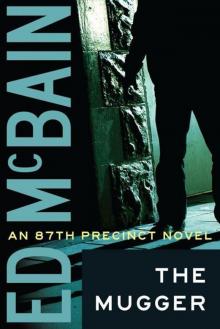 87th Precinct 02 - The Mugger
87th Precinct 02 - The Mugger 87th Precinct 09 - Til Death
87th Precinct 09 - Til Death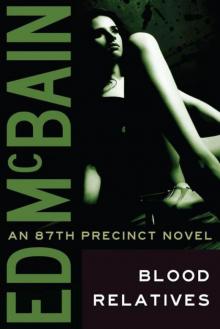 Blood Relatives (87th Precinct)
Blood Relatives (87th Precinct)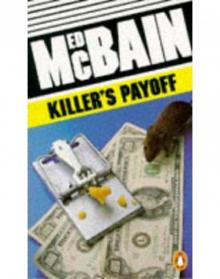 Killer's Payoff
Killer's Payoff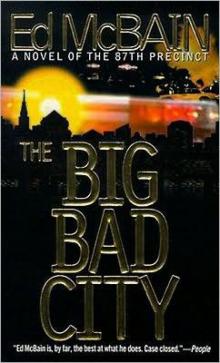 The Big Bad City
The Big Bad City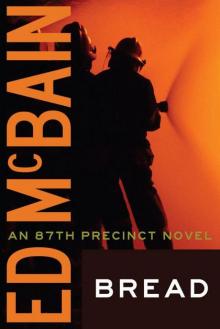 Bread (87th Precinct)
Bread (87th Precinct)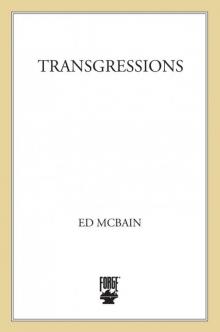 Transgressions Vol. 3
Transgressions Vol. 3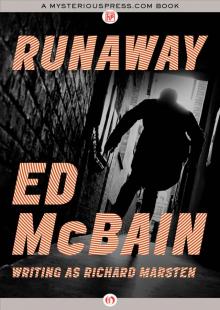 Runaway
Runaway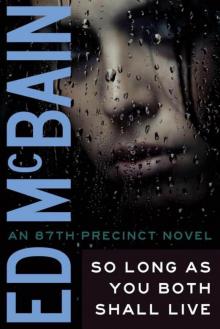 So Long As You Both Shall Live (87th Precinct)
So Long As You Both Shall Live (87th Precinct)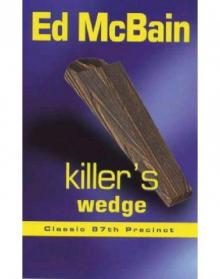 Killer's Wedge
Killer's Wedge